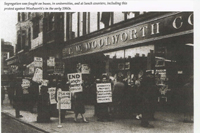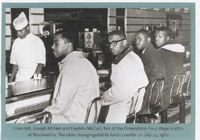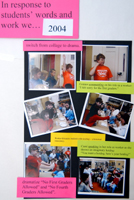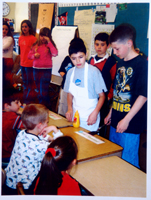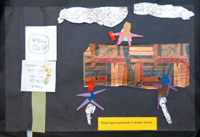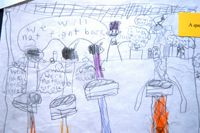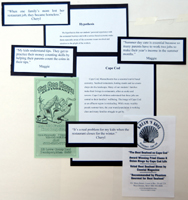For many years our goal in exploring the Sit-In Movement was for students to understand the motives, strategies and commitment of those students who sat in at lunch counters to end segregation. We stressed resistance, collaboration, perseverance and nonviolence. We acknowledged the segregationists who harassed the students, but they were never our focus. We never considered the workers until our students brought them to our attention.
Documentation Examples > Examples of documentation to aid teachers' own reflections
I Want to Help You But... Students and Teachers Uncover the Workers' Dilemma During the Sit-In Movement
School: Ezra H. Baker and John Simpkins Schools, Dennis-Yarmouth, MA
1. Another Perspective
- February 1, 1960 - Greensboro, North Carolina - Four students from the North Carolina A&T sit in at the Woolworth's lunch counter
- "In a week the Greensboro Four had grown to hundreds. Within two months protests had taken place in 125 cities in nine states." (A Dream of Freedom by Diane McWhorter)
- The students and their supporters were determined to end lunch counter segregation through massive and prolonged resistance. They recognized that their actions undermined the economic base of the community.
- The segregationists, especially those who harassed the students, were determined to keep the lunch counters segregated.
- The men and women, both black and white, who worked behind lunch counters in low paying jobs were expected to refuse service to the students sitting in regardless of their personal feelings.
Once we began documenting our study of the Sit-In Movement, we noticed that our students were interested in the workers and what part they played in the story. We began to adapt our curriculum in order to give our students access to the plight of the workers. This panel demonstrates our evolving understanding of how considering the workers' role could lead our students to a deeper understanding of the institutional nature of racism.
2. 2001 - 2003: Collage
In response to students' words and work, we switched from drawing to collage. Students portrayed the workers and showed them speaking.
3. 2004: Drama
During 2004, we switched from collage to drama. We dramatized "No First Graders Allowed" and "No Fourth Graders Allowed."
Connor commenting on his role as a worker:
"I felt sorry for the first graders."
Cami speaking in her role as worker as she throws an imaginary hotdog:
"You want a hotdog, here's your hotdog!"
4. 2005: Drawing and Drama
The next year in 2005, the students began to combine drawing and drama. In their drawings, they used both speech and thought bubbles.
Olivia thinking in her role as worker:
"I want to serve them, but then I'll get fired and I won't have any money to pay for my house."
Michaelann thinking in her role as worker:
"Why should they be in here? My manager will kick them out."
Sean thinking in his role as worker:
"They're never gonna be able to get served. Why don't they get out?"
Devin thinking in her role as worker:
"These colored people make me so mad. Why won't they leave us alone?"
Joleene thinking in her role as worker:
"Sorry."
Lee thinking in her role as student sitting-in:
"I know they want to serve me. I can see it in their eyes."
Joanne thinking in her role as student sitting-in:
"I wish they would serve me, but they like their jobs more than me."
5. 2006: Freezing the Scene
Continuing from 2005, this year the students again used both drawing and drama. While engaged in the drama, we would freeze the scene so that the characters could specifically express their thoughts.
Anthony speaking in his worker role:
"Can't you read the signs?"
Matthew thinking in his role as worker:
"If you don't leave, I'll call the police."
Adam thinking in his role as worker:
"I'll have no food for my kids."
6. Understanding the Students
Cape Cod, Massachusetts has a seasonal tourist based economy. Seafood restaurants, hotdog stands and ice cream shops dot the landscape. Many of our students' families make their livings in restaurants, often as cooks and servers. Cape Cod children understand that these jobs are central to their families' well-being. The image of Cape Cod as an affluent region is misleading. While many wealthy people summer here, the year round population is working class and many families struggle to get by.
"My kids understand tips. They get to practice their money counting skills by helping their parents count the coins in their tips."
~Maggie
"It's a real problem for my kids when the restaurant closes for the winter."
~Cheryl
"When one family's mom lost her restaurant job, they became homeless."
~Cheryl
"Summer day care is essential because so many parents have to work two jobs to make their year's income in the summer months."
~Maggie
We have learned from our students how interested they are in the workers, and how that interest reflects an understanding of the economic realities of the workers' situation.
- The workers feature prominently in our students' artwork.
- The workers have something to say.
- In both art and drama, when our students express what the workers might be thinking, they usually express sympathy for the sit-in students' point of view.
- Sometimes our students imagine the workers as hostile and in support of segregation. They demonstrate their understanding that workers had a variety of attitudes and beliefs.
- Our students continually have the workers express concern for losing their jobs and being unable to support their families.
- Our students, in their work and in discussions, reveal an understanding that the Sit-In Movement will have economic consequences for themselves and their community.
We hypothesize that our students' personal experience with the restaurant business and with a service based economy makes them especially aware of the economic issues involved and sensitive to the plight of the workers.

